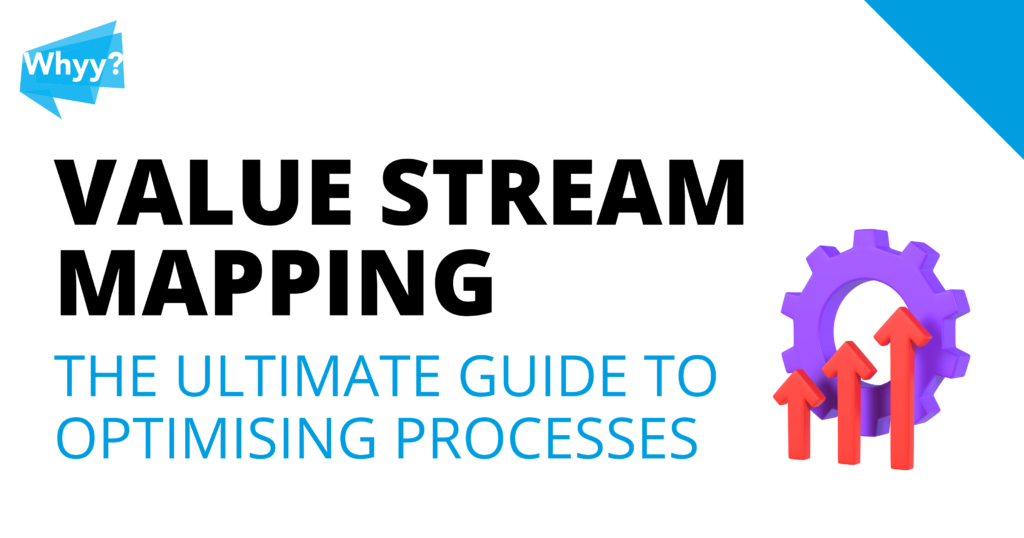What is Value Stream Mapping?
Value Stream Mapping (VSM) is a lean-management tool used to analyse and design the flow of materials and information required to bring a product or service to a consumer.
A Value Stream Map visually documents each step in the process, from raw materials to finished goods, enabling organisations to see where value is added—and where it is not. By identifying non-value-added activities, also known as “waste,” businesses can focus their improvement efforts more effectively.
Introduction to Workflow Optimisation
In today’s competitive business environment, efficiency is key. Organisations constantly seek ways to streamline their operations, reduce waste, and improve customer satisfaction. One of the most effective tools to achieve these goals is Value Stream Mapping (VSM).
By visualising the entire workflow, VSM allows businesses to identify bottlenecks, eliminate inefficiencies, and enhance overall performance. This article provides an in-depth exploration of Value Stream Mapping, offering practical insights into its implementation and benefits across various industries.
The concept of Value Stream Mapping isn’t new, but its relevance has grown significantly in recent years. Originally developed within the context of Lean Manufacturing, VSM has expanded beyond the manufacturing sector and is now widely used in healthcare, service industries, and more.
Its ability to provide a clear, visual representation of complex processes makes it an invaluable asset for any organisation looking to improve efficiency and drive continuous improvement.
Understanding Process Mapping
The History of Lean Process Mapping
Value Stream Mapping has its roots in the Toyota Production System (TPS), where it was initially developed as a means to visualise and improve manufacturing processes. Toyota engineers recognised that by mapping out the entire production process, they could more easily identify inefficiencies and implement improvements. This approach became a cornerstone of Lean Manufacturing and has since been adopted by organisations worldwide.
Key Components of Workflow Mapping
A typical workflow map includes several key elements:
- Process Steps: These are the activities that transform inputs into outputs, such as assembly or packaging.
- Information Flow: This represents the movement of information, such as orders or instructions, through the system.
- Material Flow: This shows how materials move through the production process.
- Timeline: This includes cycle times, lead times, and other time-related data that help to identify bottlenecks.
- Value and Waste Identification: Activities are categorised as either value-added or non-value-added, with the latter representing opportunities for improvement.
By focusing on these components, a Value Stream Map provides a comprehensive view of the process, making it easier to identify areas for improvement.
Benefits of Value Stream Mapping
Enhanced Process Visibility
One of the primary benefits of Value Stream Mapping is that it provides a clear, visual representation of the entire process. This visibility is crucial because it allows stakeholders to see the flow of materials and information, identify bottlenecks, and understand the relationship between different process steps. Without this level of visibility, it can be challenging to pinpoint where problems are occurring and how they can be addressed.
Improved Efficiency and Cost Reduction
By identifying and eliminating waste, workflow optimisation can lead to significant improvements in efficiency. Waste can take many forms, including excess inventory, unnecessary movement of materials, waiting times, and overproduction. By removing these inefficiencies, organisations can reduce costs, shorten lead times, and improve overall productivity. The result is a more streamlined operation that is better equipped to meet customer demands.
Identification of Waste in Processes
Waste is the enemy of efficiency, and Operational Mapping is specifically designed to root it out. By categorising each process step as either value-added or non-value-added, VSM helps organisations to focus their improvement efforts where they will have the greatest impact. Common types of waste identified by VSM include overproduction, waiting, excess transportation, over-processing, excess inventory, unnecessary motion, and defects.
Facilitation of Continuous Improvement
Value Stream Mapping is not a one-time exercise; it is a tool for continuous improvement. By regularly updating the workflow Map, organisations can monitor progress, measure the impact of changes, and identify new areas for improvement. This ongoing process of refinement ensures that the organisation remains competitive and responsive to changing market conditions.
How to Create a Value Stream Map
Steps to Develop a Value Stream Map
Creating a Value Stream Map involves several key steps:
- Identify the Product or Service: Begin by selecting the product or service that you want to map. This should be a significant process that impacts the overall performance of the organisation.
- Define the Boundaries: Determine the start and end points of the process. This will help to focus the mapping effort and ensure that all relevant steps are included.
- Gather Data: Collect data on each process step, including cycle times, lead times, inventory levels, and other relevant metrics. This data is essential for accurately mapping the process.
- Draw the Current State Map: Use the collected data to create a visual representation of the current process. This is known as the “Current State Map.”
- Analyse the Map: Identify areas of waste and opportunities for improvement. Focus on steps that are non-value-added and consider how they can be eliminated or reduced.
- Design the Future State Map: Based on the analysis, develop a “Future State Map” that represents the ideal process flow. This map should focus on reducing waste, improving efficiency, and adding value.
- Implement Changes: Once the Future State Map is finalised, develop an action plan to implement the changes. This may involve process redesign, training, or investment in new technology.
- Review and Refine: After implementing changes, review the results and update the Value Stream Map as needed. This ensures that the process remains optimised and responsive to changes.
Tools and Symbols Used in Value Stream Mapping
Value Stream Mapping uses a variety of tools and symbols to represent different elements of the process. Some common symbols include:
- Process Boxes: Represent individual process steps.
- Arrows: Indicate the flow of materials and information.
- Inventory Triangles: Show where inventory is stored within the process.
- Data Boxes: Provide additional information, such as cycle times and lead times.
- Kaizen Bursts: Highlight areas where immediate improvements are needed.
These symbols help to standardise the map, making it easier to read and understand.
Common Mistakes to Avoid
While Process Mapping is a powerful tool, it is not without its challenges. Some common mistakes to avoid include:
- Focusing Too Narrowly: It’s important to map the entire process, not just isolated components. A narrow focus can lead to suboptimal improvements.
- Neglecting to Update the Map: Value Stream Maps should be updated regularly to reflect changes in the process. Failing to do so can render the map obsolete.
- Ignoring Employee Input: The people who work within the process often have valuable insights. Ignoring their input can result in missed opportunities for improvement.
- Overcomplicating the Map: Keep the map as simple and clear as possible. Overcomplication can make it difficult to identify areas for improvement.
Applying Process Mapping in Different Industries
Process Mapping in Manufacturing
Manufacturing is where Value Stream Mapping originated, and it remains one of the most common applications of the tool. In manufacturing, VSM is used to analyse the production process, identify inefficiencies, and implement improvements. Manufacturers can reduce waste by mapping out the entire production line, optimise workflows, and improve product quality. This results in faster production times, lower costs, and increased customer satisfaction.
Applying Process Mapping in Healthcare
Value Stream Mapping has also found a home in healthcare, where it is used to improve patient care and streamline administrative processes. For example, VSM can be used to map out the patient journey from admission to discharge, identifying bottlenecks and areas of waste. Healthcare providers can reduce waiting times, improve patient outcomes, and enhance the overall patient experience by making targeted improvements.
Challenges and Solutions in Value Stream Mapping
Common Challenges in Implementation
Implementing Lean Process Mapping is not without its challenges. Some of the most common obstacles include resistance to change, inaccurate data collection, and difficulty in sustaining improvements over time. These challenges can be mitigated by involving employees in the mapping process, using reliable data sources, and fostering a culture of continuous improvement.
Overcoming Resistance to Change
Resistance to change is a common challenge in any process improvement initiative. To overcome this, it’s important to involve employees in the mapping process from the beginning. By engaging them in the process, you can gain their buy-in and reduce resistance. Additionally, clear communication about the benefits of VSM and how it will improve their work environment can help to alleviate concerns.
Ensuring Accurate Data Collection
Accurate data is essential for creating a reliable Value Stream Map. Without accurate data, the map may not accurately reflect the process, leading to suboptimal improvements. To ensure accurate data collection, use multiple data sources, cross-check information, and involve employees who are familiar with the process in the data-gathering process.
Value Stream Mapping and Lean Manufacturing
The Relationship Between Value Stream Mapping and Lean Manufacturing
Value Stream Mapping is closely aligned with the principles of Lean Manufacturing. Lean focuses on creating value for the customer by eliminating waste and improving efficiency. VSM supports these goals by providing a visual tool that helps organisations identify and eliminate waste within their processes. By integrating VSM into Lean initiatives, businesses can drive more effective and sustainable improvements.
How Value Stream Mapping Supports Lean Principles
Value Stream Mapping supports Lean principles by providing a clear, visual representation of the process. This visibility allows organisations to see where waste is occurring and take targeted action to eliminate it. Additionally, VSM encourages a culture of continuous improvement by making it easier to identify areas for improvement and measure the impact of changes.
Software Tools for Value Stream Mapping
Popular Software for Value Stream Mapping
Several software tools are available to assist with Value Stream Mapping. Some popular options include Microsoft Visio, Lucidchart, and Planview. These tools offer a range of features, including drag-and-drop functionality, pre-built templates, and collaboration tools that make it easier to create and share Value Stream Maps.
Features to Look for in Value Stream Mapping Software
When selecting software for Value Stream Mapping, it’s important to consider several key features. Look for tools that offer ease of use, flexibility, and the ability to handle complex processes. Additionally, consider whether the software offers collaboration features, integration with other tools, and robust data visualisation options. These features can make the mapping process more efficient and effective.
Training and Skills Required for Value Stream Mapping
Essential Skills for Practitioners
To effectively create and analyse Value Stream Maps, practitioners need several key skills. These include a strong understanding of Lean principles, analytical thinking, and the ability to work with data. Additionally, good communication skills are essential for engaging stakeholders and driving change based on the findings of the Value Stream Map.
Training Programs and Certifications
Several training programs and certifications are available for those looking to develop their Value Stream Mapping skills. These programs provide valuable hands-on experience and can help practitioners to develop the skills needed to implement VSM effectively.
Why complete a Value Stream Mapping Course?
Whyy? Change’s Value Stream Mapping Course will teach you how to visualise, analyse, and improve the flow of materials and information. Covering seven topics, you will learn how to identify waste, optimise production steps, and enhance efficiency in your business, making it crucial for professionals aiming to streamline operations and increase productivity. If you’re looking to help your organisation enhance productivity, cut costs, and improve overall business performance this is the course for you.
Future Trends in Lean Manufacturing
The Role of Digitalisation and Industry 4.0
As businesses continue to embrace digitalisation and Industry 4.0, Value Stream Mapping is evolving to incorporate new technologies. Digital tools such as IoT, AI, and data analytics are making it easier to collect real-time data, analyse processes, and implement improvements. These advancements are helping organisations to create more dynamic and responsive Value Stream Maps that can adapt to changing conditions.
Emerging Trends in Process Improvement
In addition to digitalisation, several other trends are shaping the future of Value Stream Mapping. These include a growing focus on sustainability, the integration of VSM with other process improvement methodologies, and the use of VSM in non-traditional sectors such as education and public services. As these trends continue to develop, Value Stream Mapping will remain a vital tool for organisations looking to optimise their processes and deliver greater value to their customers.
FAQs
What is VSM?
VSM is a visual tool used to analyse and design the flow of materials and information required to bring a product or service to a consumer. It helps organisations identify waste and areas for improvement within their processes.
How Does VSM Add Value to a Business?
By identifying and eliminating waste, VSM improves efficiency, reduces costs, and enhances overall process performance. This leads to faster production times, lower operational costs, and greater customer satisfaction.
Can VSM Be Applied to Small Businesses?
Yes, VSM can be applied to businesses of all sizes. While it is often associated with large manufacturing operations, small businesses can also benefit from the insights provided by VSM to optimise their processes and reduce waste.
How Long Does It Take to Implement Value Stream Mapping?
The time required to implement Value Stream Mapping depends on the complexity of the process being mapped and the availability of data. Simple processes can be mapped in a matter of days, while more complex processes may take several weeks.
What Are the Best Practices for Value Stream Mapping?
Best practices for Value Stream Mapping include involving employees in the mapping process, using accurate data, keeping the map simple and clear, and regularly updating the map to reflect changes in the process.
Is There a Difference Between Value Stream Mapping and Process Mapping?
Yes, while both tools are used to analyse processes, Value Stream Mapping focuses on the entire value stream and identifies waste, whereas process mapping typically focuses on individual processes and may not consider value or waste.
Conclusion
Value Stream Mapping is a powerful tool that can help organisations of all sizes and industries to optimise their processes, reduce waste, and improve efficiency.
By providing a clear, visual representation of the entire process, VSM enables businesses to identify areas for improvement and implement targeted changes that drive continuous improvement. As the business landscape continues to evolve, Value Stream Mapping will remain an essential tool for organisations looking to stay competitive and deliver greater value to their customers.
Join our next Value Stream Mapping course and start optimising your processes today.



